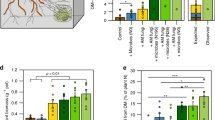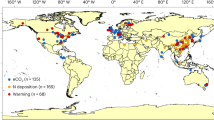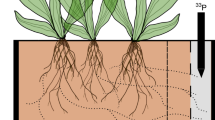Abstract
NONE of the higher fungi has yet been implicated in nitrogen fixation; at least no claims to this effect have been confirmed by the nitrogen-15 technique. It has often been suggested that the ectotrophic mycorrhizæ of certain coniferous trees might fix nitrogen, but there is no unequivocal evidence in support of this. The nitrogen-15 technique has been used to test for fixation in Pinus sylvestris L. with negative results1 and in P. radiata D. Don. with positive results3,4. In each of these investigations, plants were grown in soil or sand so that, even where evidence of fixation was obtained, the identity of the organism (or organisms) responsible for nitrogen fixation is unknown.
This is a preview of subscription content, access via your institution
Access options
Subscribe to this journal
Receive 51 print issues and online access
$199.00 per year
only $3.90 per issue
Buy this article
- Purchase on Springer Link
- Instant access to full article PDF
Prices may be subject to local taxes which are calculated during checkout
Similar content being viewed by others
References
Bond, G., and Scott, G. D., Ann. Sot. (N.S.), 19, 67 (1955).
Norkrans, Birgitta, Svensk. Bot. Tidskr., 43, 485 (1949).
Richards, B. N., and Voigt, G. K., Proc. Second. North American Forest Soils Conf., Corvallis, Oregon (in the press).
Stevenson, Greta, Ann. Bot. (N.S.), 23, 622 (1959).
Author information
Authors and Affiliations
Rights and permissions
About this article
Cite this article
RICHARDS, B., VOIGT, G. Role of Mycorrhiza in Nitrogen Fixation. Nature 201, 310–311 (1964). https://doi.org/10.1038/201310a0
Issue Date:
DOI: https://doi.org/10.1038/201310a0
This article is cited by
-
Nitrogen-fixing (acetylene-reducing) bacteria associated with ectomycorrhizae of Douglas-fir
Plant and Soil (1987)
-
Relationship between nitrogen fixation and mycorrhiza
MIRCEN Journal of Applied Microbiology and Biotechnology (1986)
-
Nitrogen fixation and mycorrhiza in podocarpus root nodules
Plant and Soil (1965)
-
Possible Role of Rhizosphere Bacteria in the Nitrogen Nutrition of Ammophila Arenaria
Nature (1964)
Comments
By submitting a comment you agree to abide by our Terms and Community Guidelines. If you find something abusive or that does not comply with our terms or guidelines please flag it as inappropriate.



